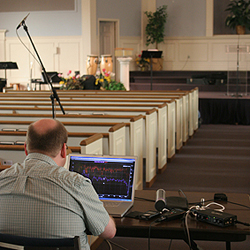Feed The Brain. The primary job of a measurement rig is to acquire electrical and acoustical signals and feed them to the processor so that it can analyze, compare, slice, dice, fold, spindle and mutilate those signals and produce multi-colored charts, graphs and the all-important squiggly lines.
“But my software can produce squiggly lines all by itself without all those bothersome wires, preamps and microphones. Isn’t that enough?”
Maybe. It depends on whether you are getting paid to pose or produce results.
We shall assume that you fall into the latter category, and therefore, the reason you have employed an analyzer is to measure your system and learn something about the signals passing through it, and in turn, what your system is doing to those signals as they pass through.
Your job is to decide what you want to measure, and from that, determine what measurement signals you need.
The point here is, the effectiveness of an analyzer is tied directly to its ability to acquire the measurement signals you need — and of course, those signals must be of a usable quality* (see note) and format.
With this basic functionality in mind, and for the purposes of this discussion, we shall divide our measurement rigs into three basic parts: probes (signal acquisition), preamps (signal transmission) and processors (signal analysis).
Probes (Signal Acquisition)
Put simply, our probes (sounds so scientific) are where we grab our measurement signals. We can split this group into two types: electrical and acoustical.
Electrical Probes
Once we have determined what electrical signals we want to grab — the points in the system signal flow we want to use as measurement points – accessing those electrical signals is basically a wiring exercise, generally accomplished via patching into device outputs or by splitting the signal path.
This is why the measurement rigs for engineers who work on many, varied systems normally include a wiring kit with a healthy selection of adapters, y-cables, impedance matching connectors and other wiring knick-knacks/doohickies (pardon the technical jargon).
When grabbing electrical signals, it is important to note that, while standard practices of splitting the signal path and routing it into your preamp/audio I/O normally does not produce noise issues (worse case: noise introduced into the signal path), it is a good idea to always be aware of system grounding and is often a good idea to carry some isolation transformers in your bag o’ tricks just in case.
Acoustical Probes
OK, microphones. There, we’ve said it.
Microphones are a critical part of our measurement rig. They are our analyzer’s window onto our acoustical environment and the signals that are arriving at our audience, artists’ and our own ears.
As tiny transducers, they are also the most variant component in our measurement rigs; from mic to mic, and also over time.
In a perfect world, our microphones would act as completely neutral acoustical probes — perfectly omni-directional with razor-flat frequency response from DC to light and 200-plus dB of dynamic range.
In the world in which we actually live and work, this is sadly not the case. It is only the ideal to which our mics aspire. So let’s get real about our measurement microphones.
The short take on the measurement mics we use for our rigs is that we need need to be honest about how close to our “ideal” mic we actually need.
It is relatively simple (and inexpensive) proposition in this day and age to produce a microphone that has a good free-field, omni-directional pattern with a respectably flat frequency response between 50 Hz and 5 kHz (and reasonably flat from 20 Hz to18 kHz), and with a dynamic range that is generally usable for measurements between 30 dB and 130 dB (SPL).
For a large number of our real-world applications, that may be all you require for your rig (and you can save money to spend on other cool gear.)
The microphone costs start increasing when you:
—expand the flat FR (particularly in extending and flattening the VHF response)
—extend the dynamic range, either raising the max SPL or dropping the self noise
—require tighter overall sensitivity ranges (mic to mic)
—require exactly matched responses
—require individual measurement plots for every mic
—increase the ruggedness and environmental capabilities
All of this is to say, you always can spend huge money on a measurement microphone if you so desire, but you may not need to for every single application.





















